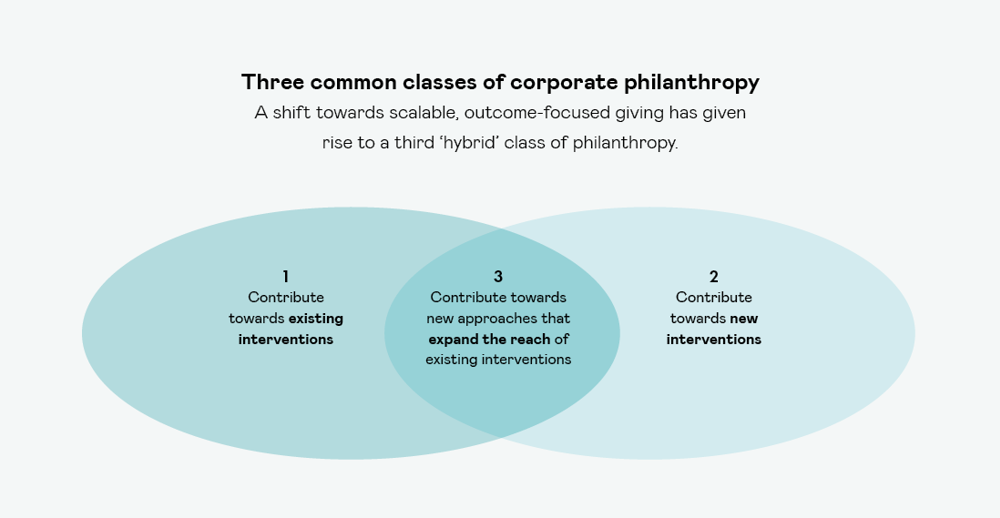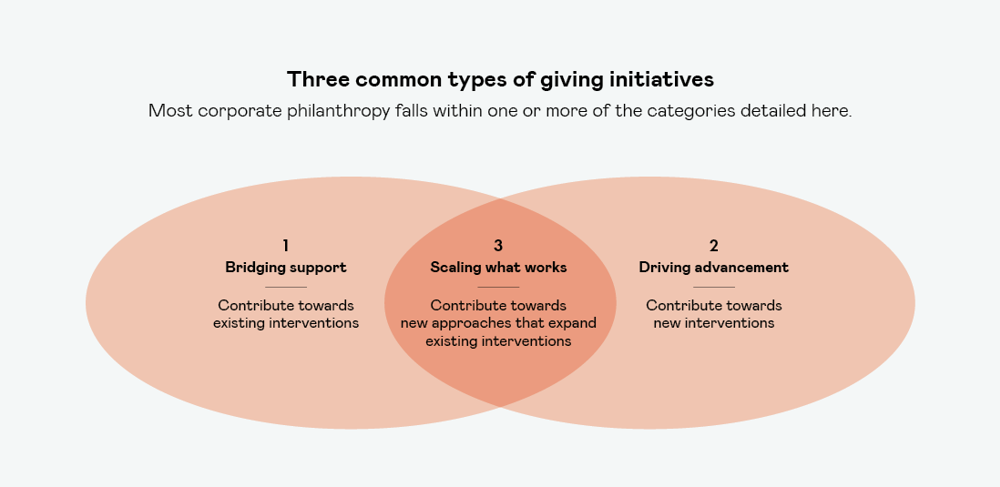Breaking the mould
This guide introduces three major classes of corporate philanthropy and provides a practical overview of the common giving initiatives associated with them

This guide introduces three major classes of corporate philanthropy and provides a practical overview of the common giving initiatives associated with them

Understanding the different classes of corporate philanthropy and the common giving initiatives related to them can help your organisation craft its own focus. This is particularly helpful in times of great need, or in the wake of a humanitarian crisis when swift action is required.
Corporate giving comes in many forms and organisations will exercise individual preference for the specifics of their giving. This may be reflected in the cause areas they work in, the beneficiaries they support, the type of resources they offer, and the way they transmit their support. Until recently, almost all corporate giving could be categorised within one of two classes:
Contributions towards existing interventions – e.g. scholarships and food banks –
have traditionally dominated corporate giving. Today, however, there is a rising trend towards philanthropy that is highly scalable, results-driven, and long term. This shift has expanded the simple two-category lineation to include a third ‘hybrid’ class. This is:
Within these three broad classes, most of the corporate philanthropy today is characterised by three distinct types of giving initiatives:
We will discuss each class and initiative in greater detail within this guide.


Whether your giving closes a budget shortfall for a well-known NGO or programme, breaks ground for a lab conducting cutting-edge scientific research, or grows a pilot programme beyond the start-up phase, all three classes of contributions are integral to the philanthropic ecosystem. Each is unique and each carries its own ratio of risk and reward, and each has an equal chance of delivering the impact you hope for.
Contributions towards existing interventions help community and civil society organisations maintain their critical operations. These organisations deliver programming that is sustained by fundraising and recurring contributions. For long-term initiatives, such as campaigns to reduce smoking in young people, this class of giving provides the year-on-year continuity that allows for meaningful progress. Although this class of giving does not always make headlines, it is a fundamental pillar of the nonprofit sector.
Bridging support initiatives ‘bridge gaps’ by filling immediate or projected resource needs for organisations and the programmes they operate. Giving initiatives of this type can be financial or in-kind. Whether it is supplementing general endowments, annual operating budgets, or covering acute gaps in funding and other resources, bridging support provides essential funding to worthy organisations and good ideas everywhere. Donors bridge support either by working with organisations to identify existing needs and gaps in the community, or by opening their doors to unsolicited proposals.
Covid-19 caught the world by surprise and many systems were ill prepared to meet the social, economic, and public health demands of the pandemic. Corporate philanthropy that responded to community needs with ‘bridging support’ type giving initiatives included those who provided an increased supply of protective equipment; supplemented food stocks at local food banks; offered cash assistance to the unemployed; reduced school tuition and rents for affected families; donated equipment for students to pursue home study; offered emergency repatriation transportation; and other types of support.
Contributions towards new interventions allow civil society and community organisations, especially universities and other innovators, to bring new concepts to life. The rewards are immeasurable and can have positive and lasting effects on whole segments of society.
New initiatives carry significant risk, and they are impossible without support. This class of giving is particularly indispensable to scientific trials and policy-related research that often relies on audacious giving to get started.
Driving advancement giving initiatives provide the resources that catalyse or deliver innovation and progress. They can be offered to new organisations, or existing organisations undertaking a new intervention. They can take many forms, from research to grassroots pilot projects. As they generally require large financial commitments, these types of initiatives are often carried out with pooled funding from like-minded donors.
Driving advancement is made possible when your organisation can either anticipate community needs or is open to proposals for riskier, unproven programmes that may not yield success or immediate outcomes. It is, however, worth noting that innovation is not always dependent on high-cost technological breakthroughs. Lower cost or analogue technologies can be as effective, particularly in rural or marginalised communities.
Contributions toward new approaches that expand existing interventions is an important hybrid class that allows good ideas and effective programming to have wider reach by finding new approaches to scale. Examples of these include identifying more efficient ways to leverage resources, distribute goods, and deliver services, as well as support pilot projects that have shown promise in their initial stages but still require significant resources in order to scale.
Initiatives to scale ‘what works’ typically provide the resources or know-how to grow proven projects. They can either support innovative approaches to reach more beneficiaries, or they simply inject increased resources needed to scale. Because greater scale often means higher capacity logistics and delivery, initiatives of this type can offer financial or in-kind support of vehicles, manpower, distribution networks and the like.
Corporate philanthropy is particularly well suited to this kind of initiative because it can efficiently transfer the intellectual property needed to support scale.
These projects are not, however, immune to risk because although pilot projects can be proven successful in the initial stages, there is no guarantee that they will resonate with larger populations or at larger scales.
The Covid-19 pandemic necessitated a quick series of technology transfers to keep critical services online. Examples of corporate philanthropy that responded with ‘scaling what works’ initiatives included assisting clinics in offering telemedicine care to reduce strain on medical systems; aiding critical government offices in offering digital customer interactions; and helping private providers to offer new payment mechanisms that allowed safer contactless deliveries.
These three general giving classes and initiatives are not the end of the road with respect to classifying corporate giving projects. Within each of type of initiative lies a virtually unlimited set of ‘categories and causes’ detailing where your giving is directed and to whom.
Categories refer to the general theme of your giving. Examples of general themes include healthcare, education, youth development, environment, and culture. Causes are a subtheme within your category. For example, causes associated with the health category could be medical research, treatment and prevention, patient support, or similar.
Imagine your organisation wishes to support the community during the Covid-19 pandemic by providing food to low-income families and individuals through the
local food bank. This foodbank came to you citing critically low food supplies and a projected influx of demand over the next few months. Your giving initiative would have the following taxonomy:
As the foodbank you support has run a supplemental food programme for over 10 years, you would be supporting an existing intervention.
As you are filling a critical gap in the foodbanks existing operations, you are bridging the foodbank’s needs with your support.
Even though your support comes during a viral pandemic, it is in support of human services and not necessarily public health.
It's a good idea to use a strong password that you're not using elsewhere.
Remember password? Login here
Our content is free but you need to subscribe to unlock full access to our site.
Already subscribed? Login here